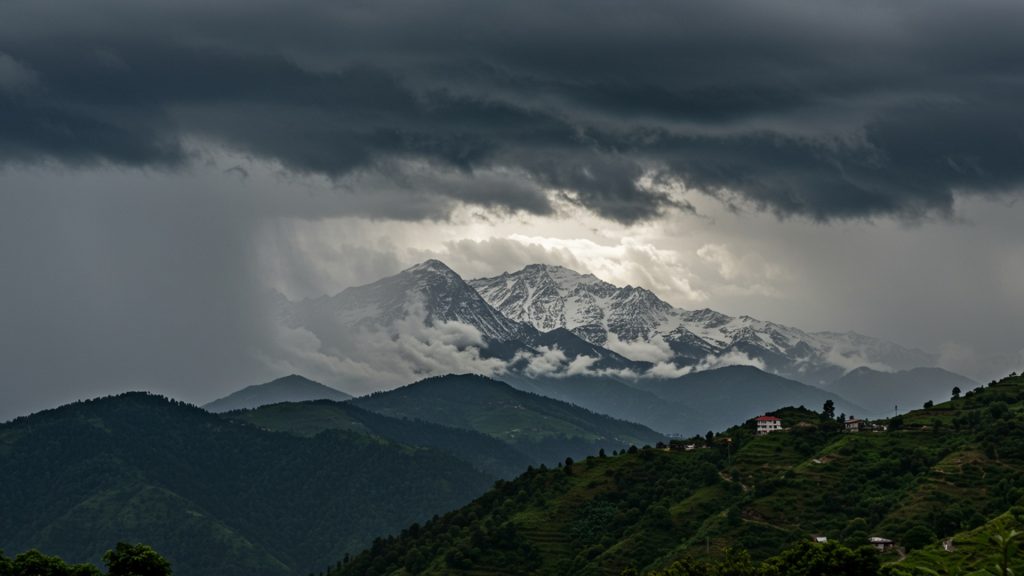The India Meteorological Department (IMD) has issued orange and yellow alerts for Uttarakhand, warning of very heavy rain in the coming days. This urgent forecast means people across the hill state, including districts like Dehradun, Nainital. Pithoragarh, should prepare for strong downpours and possible disruptions. The warnings are critical as the region is already prone to landslides and flash floods during the monsoon season, making safety a top concern for residents and visitors alike. Authorities are urging everyone to be careful and follow local advice as the heavy rainfall starts.
Rain Warnings Issued Across Uttarakhand
The India Meteorological Department (IMD) has issued orange and yellow alerts for several districts in Uttarakhand, forecasting heavy rainfall in the coming days. This warning comes as parts of the state have already experienced severe weather, leading to disruptions and safety concerns. The alerts are in place to help residents and authorities prepare for potential challenges. The IMD’s warnings indicate different levels of expected rainfall. An orange alert means that there is a warning of very bad weather that could cause problems with travel, like road and rail closures. interruptions in power supply. A yellow alert, which is a lower level, warns people about bad weather over several days. It also suggests that the weather could get worse, making daily activities difficult. On August 12, 2025, the Uttarakhand State Disaster Management Authority (USDMA) released guidelines to all District Magistrates. This was done after the weather department predicted heavy to very heavy rainfall across the state for the coming week. On August 14, 2025, the IMD had issued an orange alert for heavy rain in several districts in Uttarakhand, valid until August 17.
Areas Under Alert and Expected Rainfall
Specific districts are under various alerts depending on the expected intensity of rain. For August 12, an orange alert was in place for Dehradun, Nainital, Haridwar, Udham Singh Nagar, Pauri, Champawat. Bageshwar districts. These areas were likely to see heavy rain in isolated places. Other districts were under yellow alerts, with thunderstorms, lightning. intense rain expected in some parts. From August 13 to August 14, red alerts were active for Dehradun, Tehri, Pauri, Haridwar, Udham Singh Nagar, Nainital. Bageshwar. These districts were expected to get heavy to very heavy rain in some places, with extremely heavy rain in isolated spots. The remaining districts were under an orange alert for heavy to very heavy rainfall. On August 15, these same districts continued under an orange alert, while yellow alerts stayed for the rest of the state. According to the IMD forecast on August 15, 2025, Uttarakhand could experience extremely heavy rain (21 cm or more) on August 16 and August 17. There is also a possibility of light to moderate rainfall with thunderstorms and lightning across Uttarakhand for the next seven days. The different alert levels signify varying degrees of warning:
- Red Alert: This is the highest warning level, meaning “Take Action.” It indicates extremely high rainfall (more than 204. 5 mm in a 24-hour period) that poses severe danger to people and property, likely causing widespread floods, landslides. major disruptions.
- Orange Alert: This means “Be Prepared.” It suggests heavy to very high rainfall (115. 6 mm to 204. 4 mm in a 24-hour period) that can lead to road closures, power outages. floods. Residents are advised to take precautions.
- Yellow Alert: This is the lowest alert level, meaning “Be Aware.” It warns of moderate to heavy rain that might cause minor issues like traffic jams and waterlogging. It encourages people to stay informed and plan their activities carefully.
Recent Impacts of Heavy Rain
Uttarakhand has already been facing the effects of continuous heavy rain. On August 11, 2025, Dehradun, the state capital, recorded its highest single-day rainfall in 74 years in August, with a staggering 200mm of rain in 24 hours. This has brought normal life to a standstill. The heavy rain has led to several problems:
- House Collapses: Two houses in Patel Nagar and one near Lakshman Chawk in Dehradun collapsed on August 11 due to heavy rain. No human casualties were reported.
- Uprooted Trees: About half a dozen trees were uprooted in Dehradun at places like Rajpur Road, Ishwar Vihar. Canal Road. Efforts are ongoing to remove them.
- Waterlogging: Widespread waterlogging was reported in about a dozen colonies including Nehrugram, Kishanpur Canal Road. Natthanpur.
- Landslides and Road Closures: A landslide occurred in Guniyal village near Dehradun. Over 300 roads remained closed as of August 13 due to landslides and flooding caused by continuous rains. In Bageshwar, 12 roads were blocked, isolating about 50 villages. The route to Yamunotri Dham in Uttarkashi was shut due to falling stones and debris.
- Bridge Collapses: On August 6, the West Nayyar River overflowed in Pauri Garhwal district, destroying a vital bridge connecting Thalisain and Pabo blocks. The Kalgarhi bridge on National Highway 121 also collapsed, further isolating interior villages.
- Pilgrimage Suspensions: The Kedarnath Yatra was suspended from August 13 to August 15. Pilgrims were stopped from going to Kedarnath from Sonprayag. Travel to Badrinath and Hemkund Sahib was also severely affected.
- Disruptions to Services: In Kothla village, the entire drinking water supply system failed. Large parts of the district experienced power outages and mobile network failures since August 6.
The current weather for Saturday, August 16, 2025, in Garhwal Division is mostly cloudy, with a 65% chance of heavy thunderstorms during the day and light rain at night.
Government Actions and Preparedness
In response to the severe weather forecast and ongoing challenges, the Uttarakhand government and various authorities have taken several steps to manage the situation and ensure public safety. The Uttarakhand State Disaster Management Authority (USDMA) has issued detailed guidelines to all District Magistrates. Authorities have been told to monitor traffic, provide timely updates. ensure emergency readiness. Officers of the Indian Revenue Service (IRS) rank have been instructed to remain on high alert. Various departments and agencies are involved in the preparedness efforts:
- The Public Works Department (PWD) and Border Roads Organisation (BRO) have been directed to keep roads clear in case of blockages.
- Police stations and village heads have been advised to keep essential items like torches, plastic sheets, helmets. umbrellas ready. Officials are also told to keep their phones working at all times.
- The USDMA has also issued public advisories. People living near rivers, streams, low-lying areas. floodplains have been urged to stay alert and be ready to move to higher ground.
- Pilgrims and tourists, especially those traveling to Char Dham and other holy sites, are advised to avoid travel during this period.
- Dam and barrage management authorities, along with hydroelectric plants, have been told to keep reservoir levels at a minimum.
- Mountaineering expeditions are advised to stop and move to safe areas.
The state government has suggested that district authorities close schools. Commuters are advised to avoid unnecessary travel. People are urged to stay indoors during heavy rain or flash floods, avoid areas prone to landslides, refrain from crossing flooded zones. stay away from swollen rivers and lakes. Military and paramilitary posts in vulnerable regions have been told to stay on alert. Construction work on houses, bridges, dams. tunnels should be paused during heavy rain. Farmers have also been advised to ensure proper drainage in their fields and keep harvested crops in safe, dry places. Chief Minister Pushkar Singh Dhami held a high-level meeting to review disaster management and safety measures. He directed officials to identify sensitive locations prone to landslides, avalanches. other natural disasters in hilly areas. He stressed the importance of taking precautions before potential dangers arise and stated that no new settlements or construction activities would be allowed in identified risk-prone areas. The Governor of Uttarakhand, Lt. Gen. Gurmit Singh (Retd.) , also reviewed the state’s disaster response and ordered a 24-hour alert during the active monsoon season. He emphasized learning from past incidents, like the recent disaster in Dharali, to improve future responses. He noted that extensive survey work is underway at sites like the lake formed in Harsil and the Dharali-Mukhba bridge to ensure structural integrity. The state is using technology to improve its disaster preparedness. A network of high-tech control rooms operates across the state, with the State Emergency Operation Centre in Dehradun as the main hub. These centers are directly linked to the IMD, receiving live weather updates, river-level readings. landslide alerts. When IMD issues a warning, the insights is instantly shared with USDMA, which then coordinates with district-level control rooms. The State Disaster Response Force (SDRF) has received specialized training for monsoon preparedness, including swift-water rescue and rope-based extractions from landslide zones. Villages in high-risk areas are also being trained in community-based disaster preparedness, with drills to ensure people know evacuation routes and safe assembly points. For tourism safety, major routes like the Char Dham circuit now have digital boards showing weather alerts. police checkpoints act as data points for travelers. This helps in closing routes and diverting tourists before danger arises.
Understanding the Monsoon in Uttarakhand
Uttarakhand’s mountainous terrain makes it especially vulnerable to heavy rainfall. This year, the state has experienced its most extreme monsoon since 2022. From June 1 to August 5, 2025, the state recorded 43 days of extreme weather out of 66, which is the highest for this period in the past four years. This means that 65 percent of the days so far this monsoon have seen extreme weather events. Scientists link the increase in extreme weather to climate change, noting that the IMD reported Uttarakhand’s warmest monsoon since 1901 in 2024. This was marked by very high temperatures and more intense rainfall due to warmer, moisture-filled air. Experts also warn that poor planning, fast growth of buildings. weak early warning systems are making the situation worse. The monsoon season, from June to September, brings more than 70 percent of the annual rainfall to the Indian subcontinent. Changes in snowfall and rainfall patterns due to climate change have made the Himalayan mountains more likely to experience problems.

